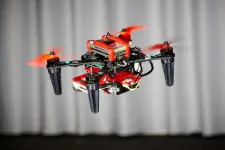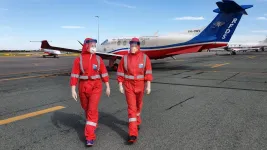How to keep drones flying when a motor fails
2021-01-13
(Press-News.org) As anxious passengers are often reassured, commercial aircrafts can easily continue to fly even if one of the engines stops working. But for drones with four propellers - also known as quadcopters - the failure of one motor is a bigger problem. With only three rotors working, the drone loses stability and inevitably crashes unless an emergency control strategy sets in.
Researchers at the University of Zurich and the Delft University of Technology have now found a solution to this problem: They show that information from onboard cameras can be used to stabilize the drone and keep it flying autonomously after one rotor suddenly gives out.
Spinning like a ballerina
"When one rotor fails, the drone begins to spin on itself like a ballerina," explains Davide Scaramuzza, head of the Robotics and Perception Group at UZH and of the Rescue Robotics grand challenge at NCCR Robotics, which funded the research. "This high-speed rotational motion causes standard controllers to fail unless the drone has access to very accurate position measurements." In other words, once it starts spinning, the drone is no longer able to estimate its position in space and eventually crashes.
One way to solve this problem is to provide the drone with a reference position through GPS. But there are many places where GPS signals are unavailable. In their study, the researchers solved this issue for the first time without relying on GPS, instead using visual information from different types of onboard cameras.
Event cameras work well in low light
The researchers equipped their quadcopters with two types of cameras: standard ones, which record images several times per second at a fixed rate, and event cameras, which are based on independent pixels that are only activated when they detect a change in the light that reaches them.
The research team developed algorithms that combine information from the two sensors and use it to track the quadrotor's position relative to its surroundings. This enables the onboard computer to control the drone as it flies - and spins - with only three rotors. The researchers found that both types of cameras perform well in normal light conditions. "When illumination decreases, however, standard cameras begin to experience motion blur that ultimately disorients the drone and crashes it, whereas event cameras also work well in very low light," says first author Sihao Sun, a postdoc in Scaramuzza's lab.
Increased safety to avoid accidents
The problem addressed by this study is a relevant one, because quadcopters are becoming widespread and rotor failure may cause accidents. The researchers believe that this work can improve quadrotor flight safety in all areas where GPS signal is weak or absent.
https://youtu.be/Ww8u0KH7Ugs
INFORMATION:
Literature:
Sihao Sun, Giovanni Cioffi, Coen de Visser, Davide Scaramuzza: Autonomous Quadrotor Flight despite Rotor Failure with Onboard Vision Sensors: Frames vs. Events. January 5, 2021, IEEE Robotics and Automation Letter. DOI: 10.1109/LRA.2020.3048875
[Attachments] See images for this press release:

ELSE PRESS RELEASES FROM THIS DATE:
2021-01-13
A recent Point of Reference article, "The meat of the matter: Environmental dissemination of beef cattle agrochemicals," published in Environmental Toxicology and Chemistry, points at synthetic chemical cocktails being emitted from cattle feed yards into the environment and how they can impact our ecosystem and our health.
Industrial meat production facilities have a bad reputation for their impact on the environment. Concentrated animal feeding operations (CAFOs) are known to release greenhouse gases related to global warming and for discharge of manure to watersheds, which affects water quality. A less publicized impact of modern beef production is the excessive use of ...
2021-01-13
Our immune system is never idle. Their task is to detect and eliminate invasive pathogens, and they have no time to lose. The adaptive immune system identifies infectious organisms by recognizing foreign proteins on the surfaces of bacteria, viruses and unicellular protozoans. The interaction of these antigens with immune cells triggers a series of downstream events, which in most cases leads to the elimination of the pathogen.
But pathogenic organisms have developed strategies that enable them to escape detection by the immune system, and the strategies employed by remotely related organisms are often remarkably similar to each other. One way of confusing the immune system is to increase the structural heterogeneity of the antigens it encounters. ...
2021-01-13
(Philadelphia, PA) - Like a failing fuel pump that causes a loss of engine power in a car, a diseased heart can take a serious toll on the body's performance. For some patients, tasks like walking up a flight of stairs or walking across a room eventually turn into exhausting endeavors. This is because, over time, regardless of the underlying cause, heart damage typically progresses, owing to a constant barrage of oxidative stress and toxic lipids that alter heart cell energetics and, ultimately, the ability of the heart to function normally.
Oxidative stress occurs when harmful oxygen-containing molecules outnumber helpful antioxidants, leading to damaging reactions with proteins, DNA, and other cell components. ...
2021-01-13
New data released this week by Australian researchers reveals the impact of the COVID-19 lockdown period on aeromedical retrievals in rural and remote regions.
Researchers say while the social isolation measures led to a reduction in overall aeromedical activity during the lockdown in 2020, once the restrictions were lifted, evacuations increased significantly.
These findings are published in the Internal Medicine Journal, comparing aeromedical evacuation trends in Australia during the pre-restriction, lockdown and post-restriction periods last ...
2021-01-13
A Simon Fraser University study on public perceptions of police officers wearing personal protective equipment (PPE) during the current pandemic finds that most PPE renders positive perceptions of police, while some equipment, including full-face respirator masks, may be viewed more negatively. The research was published January 9 in the Journal of Experimental Criminology.
Led by SFU criminology assistant professor Rylan Simpson and MA student Ryan Sandrin, the online experimental study drew on a sample of 117 participants residing in North America. The participants were randomly assigned to read one of three fictitious news articles that were either pro-PPE (highlighting health benefits), neutral or anti-PPE (lacking health benefits). Participants were then asked to rate 12 ...
2021-01-13
The Granzyme B (GzmB) enzyme, which accumulates in certain tissues as we age, has been identified as a driver of itchy and sometimes life-threatening autoimmune conditions known as pemphigoid diseases (PDs), which cause blistering and skin erosion below the skin's surface.
New research led by University of British Columbia (UBC) and Vancouver Coastal Health Research Institute (VCHRI) scientists has found that a gel containing a specific and potent inhibitor of GzmB activity, VTI-1002, resulted in significant improvements on skin affected by PDs.
"Blisters caused by these conditions can be extremely discomforting, unsightly and ...
2021-01-13
A proton exchange membrane fuel cell is a chemical cell that converts energy released when a substance reacts into electrical energy with zero emission. It is an excellent substitute for fossil fuel.
However, low activity and stability of the Pt-based catalysts in the oxygen reduction reaction (ORR) of the battery cathode restricted the output power and the number of charge and discharge cycles, thus increasing the cost of the whole fuel cells. The preparation of cathode catalysts with high activity and stability is a difficult problem.
In a study ...
2021-01-13
Durham, NC - A new study reported in STEM CELLS reveals a unique population of skeletal stem cells (SSCs) that function during the transitional period between rapid bone growth and bone maintenance. This discovery provides an opportunity to determine whether alterations in the SSCs' pattern might affect bone formation, as well as helps us understand the physiological factors that regulate its timing.
"This is particularly important given that anything that interferes with the proper development of bone mass during childhood and adolescence has long-lasting effects on our health, including the development of osteoporosis ...
2021-01-13
BINGHAMTON, NY -- A new leader takes office and foreign rivals begin to test the waters. How tough is this new leader? Are they willing to risk war, or just full of bluster?
This testing can escalate crises, increasing the risk of war as international adversaries gauge the new leader's willingness to use force. A new paper co-written by faculty at Binghamton University, State University of New York shows that when this "turnover trap" occurs depends a good deal on the politics back home, and the nature of the leader's transition into office.
Binghamton University Associate Professor of Political Science Amanda Licht was among ...
2021-01-13
AURORA, Colo. (Jan. 13, 2021) - Mucus in the lungs can be fatal for asthma patients, but scientists at the University of Colorado Anschutz Medical Campus have broken up those secretions at the molecular level and reversed their often deadly impacts.
In a study published Monday in the journal Nature Communications, the researchers explained how they created an inhaled treatment that disrupted the production of excess mucus by reducing disulfide bonds in mice and opening up their airways. The same treatment had similar impacts on human mucus samples.
"Currently about 10% of the population has asthma," said the study's lead author Christopher Evans, PhD, professor of Pulmonary Sciences & Critical ...
LAST 30 PRESS RELEASES:
[Press-News.org] How to keep drones flying when a motor fails


